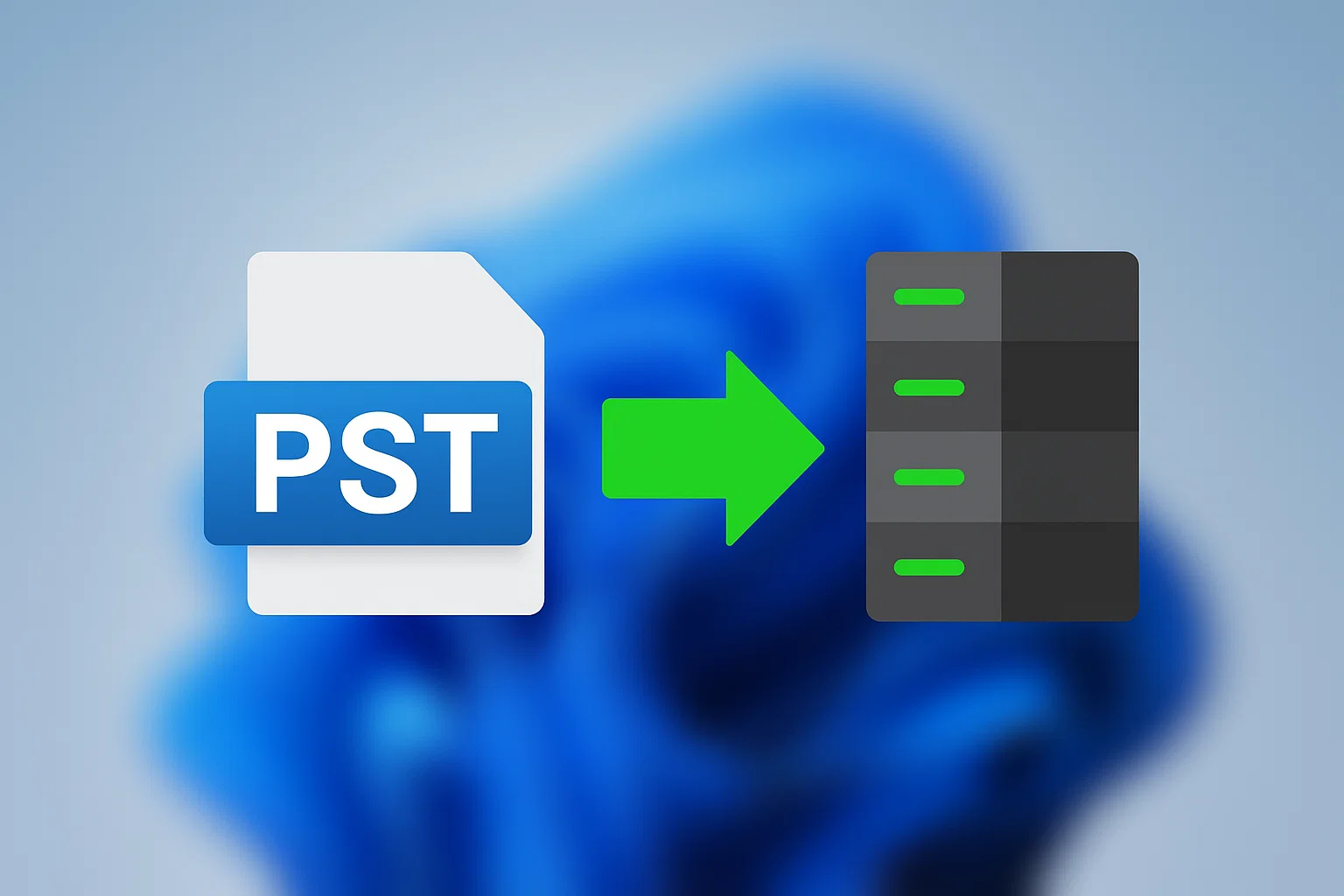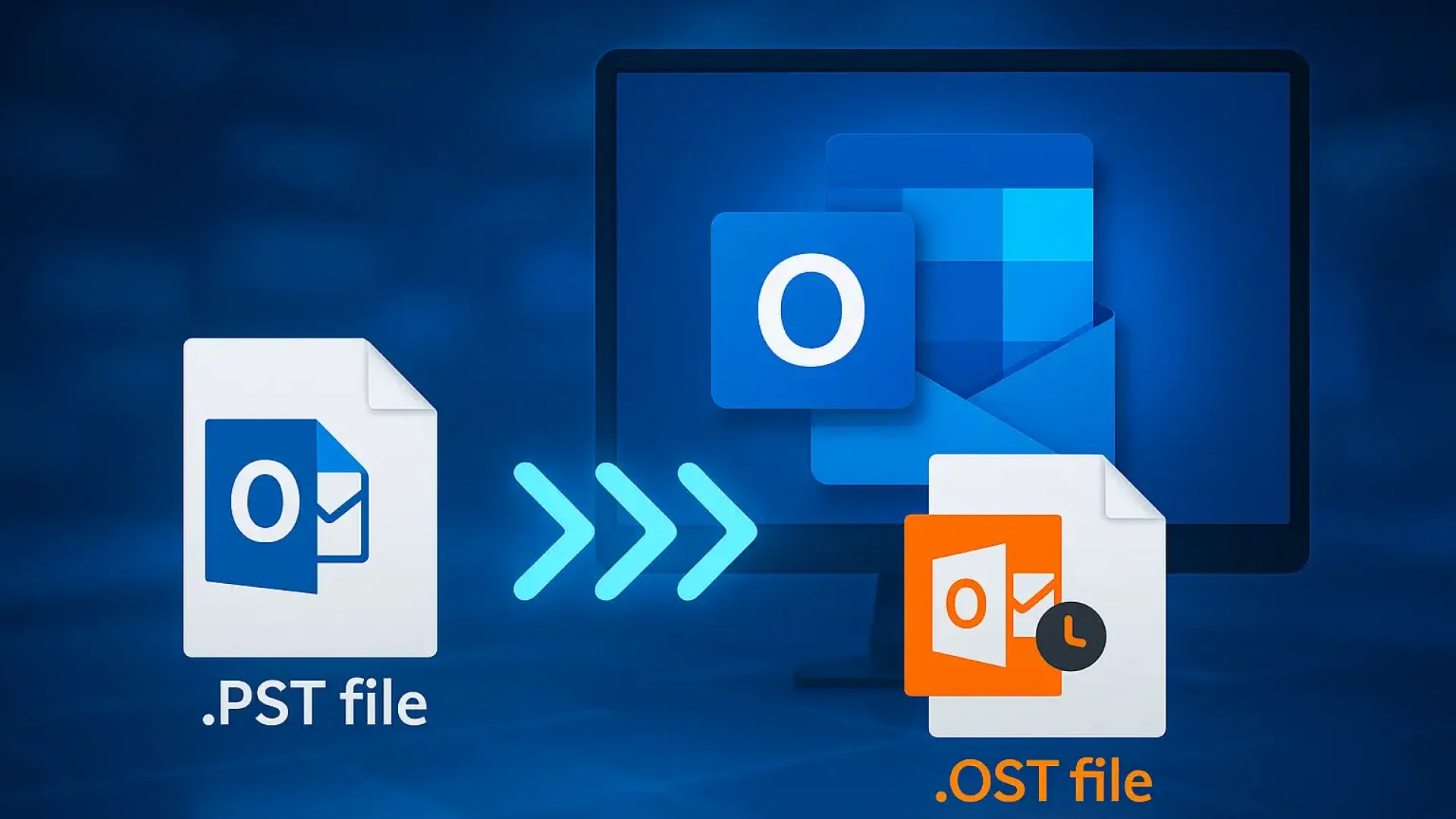In the program Microsoft Outlook Data files such as PST (Personal Storage Table) and OST (Offline Storage Table) files play a crucial role in storing emails, calendars, contacts, and other user information. By default, Outlook sets size limits for these files to ensure optimal performance and stability of the application. However, as email usage increases and large amounts of data accumulate, users may experience issues with reaching these limits, which can lead to synchronization errors, slowdown in action program and even data loss.
In this article, we will provide you a detailed guide to increase PST and OST file size limits in Outlook for Windows. We will discuss the differences between PST and OST files, the default size limits in different versions of Outlook, and the steps necessary to modify the system registry to increase these limits. Additionally, we will share best practices for managing large data files and answer frequently asked questions related to this topic.
Whether you are an IT administrator, a small business owner, or an individual user, this guide will help you effectively manage the size of your data files in Outlook, ensuring a smooth and hassle-free user experience.

How to Increase PST and OST File Size Limit in Outlook
Increasing the size limit of Outlook data files (PST and OST) is possible by modifying the Windows system registry. Below is detailed instructions, how to do it safely and effectively.
Step 1: Close Outlook
Before making any changes, make sure Outlook is completely closed.
Step 2: Open the registry editor
Press the keys
Windows + Rto open the Run dialog box.Enter
regeditand press Enter.
Step 3: Navigate to the appropriate registry key
In the Registry Editor, navigate to the path that corresponds to your version of Outlook:
• Outlook 2003:
HKEY_CURRENT_USER\Software\Microsoft\Office\11.0\Outlook\PST• Outlook 2007:
HKEY_CURRENT_USER\Software\Microsoft\Office\12.0\Outlook\PST• Outlook 2010:
HKEY_CURRENT_USER\Software\Microsoft\Office\14.0\Outlook\PST• Outlook 2013:
HKEY_CURRENT_USER\Software\Microsoft\Office\15.0\Outlook\PST• Outlook 2016/2019/2021/365:
HKEY_CURRENT_USER\Software\Microsoft\Office\16.0\Outlook\PST
Attention: If the key PST does not exist, right click on Outlook, choose New > Key and name it PST.
Step 4: Create or Modify Registry Values
In the right panel, right-click and select New > DWORD (32-bit) value.
Create or modify the following values:
• MaxLargeFileSize– specifies the maximum file size in megabytes (MB).• WarnLargeFileSize– specifies the size at which a warning will appear that the size is approaching the limit.
Example: To set the limit to 100 GB:
• MaxLargeFileSize= 102400• WarnLargeFileSize= 97280
Attention: It is recommended that the value WarnLargeFileSize was at least 5% less than MaxLargeFileSizeto ensure that Outlook functions properly.
Step 5: Apply changes
Close Registry Editor.
Restart your computer for the changes to take effect.
Open the program Outlook and check if the new limits have been taken into account.
Warnings and best practices
• Do not exceed 100 GB: While it is technically possible to set higher limits, doing so can lead to Outlook performance and stability issues.
• Archive data regularly: Large PST and OST files can be susceptible to corruption. Regular backup and archiving of data will help avoid information loss.
• Monitor file sizes: Regularly checking the size of your data files will allow you to detect potential problems early.
Following the above steps and recommendations will allow you to safely increase the size limit of PST and OST files in Outlook while ensuring stability and performance applications.
Differences Between PST and OST Files in Outlook
Microsoft Outlook stores user data locally in two main file types: PST (Personal Storage Table) and OST (Offline Storage Table). Understanding the differences between them is crucial for effective management mailbox, especially in the context of increasing the size limits of these files.
PST (Personal Storage Table) file
Application:
• Used to store data from POP3, IMAP and webmail accounts.
• Used to archive, back up, and transfer data between different Outlook installations.
Characteristic:
• Data is stored locally on the user's computer.
• PST files can be easily transferred and imported on other devices.
• The maximum default PST file size in newer versions of Outlook is 50 GB, with the option to increase it to 100 GB by editing the system registry.
OST (Offline Storage Table) file
Application:
• Created automatically when you set up Exchange, Microsoft 365, or Outlook.com accounts in cached mode.
• Allows you to work offline; changes are synchronized with the server when you reconnect to the network.
Characteristic:
• Data is stored locally but is a copy of the data from the server.
• OST files are specific to a given Outlook profile and cannot be easily transferred between different installations.
• The default OST file size limit in newer versions of Outlook is 50 GB, with the option to increase it by editing the registry.
Comparison of PST and OST
| Characteristic | PST | OST |
|---|---|---|
| Account Type | POP3, IMAP, webmail | Exchange, Microsoft 365, Outlook.com |
| Offline work | Limited | Full |
| Server synchronization | Manual or none | Automatic |
| Portability | Easy to transfer and import | Related to a specific Outlook profile |
| Application | Archiving, backups, data migration | Offline work, server synchronization |
| Maximum default size | 50 GB (can be expanded) | 50 GB (can be expanded) |
• Monitor regularly size of data files to avoid performance issues.
• For PST files, consider archiving them or splitting them into smaller pieces for easier management.
• For OST files, remember that they are a copy of the data from the server; if there are problems, you can delete them and let Outlook re-create them.
Understanding the differences between files PST and OST and their proper management is crucial to keeping Outlook running smoothly, especially in data-intensive environments.

Default PST and OST file size limits in different Outlook versions
Understanding the default size limits for data files in Outlook is essential for effectively managing your mailbox and avoiding data storage problems. These limits vary depending on your Outlook version and file format (ANSI or Unicode).
Default PST and OST file size limits
| Outlook version | File format | Default size limit | Maximum recommended limit after registry modification |
|---|---|---|---|
| Outlook 2002 and earlier | ANSI | 2GB | 2 GB (no increase possible) |
| Outlook 2003–2007 | Unicode | 20GB | 50GB |
| Outlook 2010–2024, Microsoft 365 | Unicode | 50GB | 100GB |
Attention: ANSI files are limited to 2 GB and do not support Unicode characters, which can lead to encoding and compatibility issues. Therefore, it is recommended to use Unicode format in newer versions of Outlook.
Possibility to increase limits by editing the registry
For Outlook 2010 and later versions, it is possible to increase the size limits of PST and OST files by modifying the system registry. These values can be set to 100 GB, but it is important to remember that too large files can negatively affect the program's performance.
Example registry values for Outlook 2016/2019/2021/365:
• MaxLargeFileSize: 102400 (equivalent to 100 GB)• WarnLargeFileSize: 97280 (equivalent to 95 GB)
Attention: It is recommended that the value WarnLargeFileSize was set to at least 5% less than MaxLargeFileSizeto enable internal Outlook processes such as indexing and synchronization.
Potential Problems with Large Data Files
Too large PST or OST files can lead to:
• Outlook slows down
• Server synchronization errors
• Problems with creation backups and archiving
Therefore, even if it is possible to increase the limits, it is recommended to regularly archive data and monitor the size of data files.
In the following chapters, we will discuss in detail how to safely increase the size limits of PST and OST files by editing the registry and present best practices for managing large data files in Outlook.
Preparing to edit the system registry
Increasing the size limit of PST and OST files in Outlook requires modifying the Windows system registry. This is a technical operation that, if performed incorrectly, can lead to serious problems with the operating system. Therefore, before starting any changes, you should carefully prepare for this process.
Warning about editing the registry
The Windows registry is a central database that stores settings and options for the operating system and installed applications. Incorrect changes to the registry can lead to system instability, application errors, or even prevent the system from starting. Therefore, it is recommended that registry editing be performed by people with the appropriate technical knowledge.
Creating a backup
Before making any changes to the registry, you should back it up. This will allow you to restore it to a previous state in case of problems;
Press the keys
Windows + R, enterregeditand press Enter to open the Registry Editor.In the menu, select
File>Export.In the section
Export ScopechooseThe entire register.Select a location to save the backup file, give it a name (e.g.
backup_registry.reg) and clickSave.
To restore the registry from a backup, simply double-click on the saved file .reg and confirm your willingness to make changes.
Preparing the system for editing the registry
Before modifying the registry:
• Close Outlook: Make sure Outlook is not running.
• Close other applications: To avoid conflicts, close all other programs.
• Make sure you have administrator privileges: Administrative privileges are required to edit the registry.learn.microsoft.com
Once you have completed the above steps, you are ready to safely edit the registry to increase the size limit of PST and OST files in Outlook. In the following sections, we will provide a detailed step-by-step guide on how to make these changes.

Potential Issues and Their Solutions After Increasing PST/OST File Limit
Increasing the size limit of data files in Outlook can solve the problem of inbox overflow, but it also carries the risk of new complications. Large PST and OST files can affect the application's performance, cause synchronization errors, and even lead to data corruption. Below are the most common problems and best practices for solving them.
Outlook slows down
Symptoms:
• Slow program startup.
• Stuttering when viewing messages.
• Delays in sending and receiving emails.
Reasons:
• OST/PST files larger than 10 GB may cause brief application hangs, especially on older hardware or slower hard drives.
Solutions:
• Regular archiving of older messages.
• Compact data files to reclaim unused space.
• Moving large attachments outside of Outlook, such as to OneDrive or SharePoint.
Sync Errors and Folder Issues
Symptoms:
• No folder updates.
• Exchange Server synchronization errors.
• Issues with calendar or shared folders.
Reasons:
• Too many items in folders (over 100,000) or too many folders (over 10,000) can lead to performance and synchronization issues.
Solutions:
• Limit the number of items synced by setting a shorter sync period (e.g. 6 months instead of “All”).
• Disable shared folder syncing unless necessary.
• Moving older items to an online archive or local PST file.
Compacting PST and OST files
Why it's worth it:
When you delete items from Outlook, the data files do not automatically shrink. Compacting allows you to reclaim unused space and improve the program's performance.
How to do it:
In Outlook go to
File>Account settings>Account settings.On the card
Data filesselect the appropriate PST or OST file and clickSettings.Choose
Compact nowand confirm.
Attention: The process may take several minutes depending on the file size.
Data archiving and management
Best practices:
• Use the AutoArchive feature to automatically move older messages to separate PST files.
• Creating manual archives for specific projects or time periods.
• Regularly review and delete unnecessary messages and attachments.
Benefits:
• Reducing the size of main data files.
• Improved Outlook performance.
• Manage and find important information more easily.
Additional tips
• Avoid exceeding 50 GB for OST and PST files, even if you increase the limit in the registry. Overly large files can lead to performance and stability issues with the program.
• Regularly monitor the size of data files and implement appropriate preventive measures.
• Use tools such as
scanpst.exeto repair corrupted PST files.
Remember that proper management of data files in Outlook is not only prevents problems, but also ensures smooth and efficient use of the program.

Best Practices for Managing Large PST and OST Files
Effective management The size of Outlook data files, such as PST and OST, is crucial to ensuring the application runs smoothly and avoiding performance and synchronization issues. Below are proven methods and tools to help keep your data files in optimal condition.
Regularly clean your inbox
Why it's important:
Over time, your inbox can accumulate a large volume of messages, which leads to the increase in the size of your PST and OST files. Regularly deleting unnecessary messages and attachments helps keep your data files at a manageable level.
How to do it:
Use the tool Cleaning the box:
• In Outlook, go to
File>Tools>Cleaning the box.• Check the size of the mailbox and individual folders.
• Find and delete messages older than a specific period or larger than a specific size.
Remove items from folder Removed items:
• Right click on the folder
Removed itemsand chooseEmpty folder.
Data archiving
Why it's important:
Moving older messages to separate PST archive files allows you to reduce the size of the main data files and improve Outlook performance.
How to do it:
Configure Self-archiving:
• In Outlook, go to
File>Options>Advanced>AutoArchive Settings.• Set the archiving frequency and archive file location.
Manual archiving:
• Go to
File>Tools>Archive.• Select the folders to archive and specify the date before which messages should be archived.
Cached mode synchronization limitation
Why it's important:
Syncing your entire mailbox in cached mode can lead to large OST files and performance issues.
How to do it:
Go to
File>Account settings>Account settings.On the card
E-mailselect your account and clickChange.Customize slider
Cached Exchange Mode Settingsto sync only the last few months of messages (e.g. 6 months).
Compacting data files
Why it's important:
When you delete messages, Outlook doesn't always automatically reduce the size of PST and OST files. Manual compaction allows you to reclaim unused space.
How to do it:
Go to
File>Account settings>Account settings.On the card
Data filesselect the appropriate file and clickSettings.Click
Compact now.
Monitoring the size of data files
Why it's important:
Regularly checking the size of PST and OST files allows you to detect problems early and take appropriate action.
How to do it:
In Outlook go to
File>Account settings>Account settings.On the card
Data filescheck the size of individual data files.
Using Data File Repair Tools
Why it's important:
In case of corruption of PST or OST files, the tool scanpst.exe allows them to be repaired and data recovered.
How to do it:
Close Outlook.
Start
scanpst.exe(usually located in the Outlook installation folder).Select the PST or OST file to repair and follow the instructions.
Applying the above practices will allow you to effectively manage data files in Outlook, ensuring the stability and performance of the application.

Alternative methods to manage large PST and OST files
Managing large Outlook data files (PST and OST) doesn't have to be limited to modifying the system registry. There are other, more flexible and scalable methods that allow you to effectively control the size of these files, minimizing the risk of performance degradation or data corruption.
Using Group Policy to Manage File Sizes
In enterprise environments, IT administrators can use Group Policy to centrally manage Outlook settings, including PST and OST file size limits.
Steps:
Download and install the appropriate Administrative Templates (ADMX) for the version of Office used in your organization.
Open the Group Policy Management Editor.
Go to:
User configuration>Administrative templates>Microsoft Outlook>Data File Settings.Configure the appropriate settings such as
Maximum PST file sizeWhetherFile size limit approaching warning.
With this approach, changes are applied globally, which ensures consistency and facilitates management in large organizations.
Limit data syncing with the cached mode slider
Outlook offers the ability to limit the amount of data synchronized locally by setting a synchronization time range.
How to do it:
In Outlook go to
File>Account settings>Account settings.Select an account and click
Change.Use the slider
Cached Exchange Mode Settingsto specify a synchronization range (e.g. 3 months, 6 months).
Limiting sync to a shorter period reduces the size of the OST file, which can improve Outlook performance, especially on devices with limited storage space.
Using PST File Management Tools
There are specialized tools that allow advanced management of PST files, such as splitting, merging, or compressing them.
Example tools:
• Inbox Repair Tool (scanpst.exe) – used to repair corrupted PST files.
• Third Party Tools – offer features such as splitting large PST files into smaller pieces, making them easier to manage and archive.
Regular use of these tools helps keep PST files in optimal condition, minimizing the risk of corruption.
Transferring data to the cloud
Instead of storing large amounts of data locally, you may want to consider moving some of your data to the cloud.
Benefits:
• Reduce the size of local PST and OST files.
• Access to data from various devices and locations.
• Increased security and data protection thanks to cloud solutions.
Services like Microsoft 365 offer the ability to store data in the cloud, which can make managing large data sets much easier.
Monitoring and analyzing the size of data files
Regularly monitoring the size of PST and OST files allows you to detect potential problems early and take appropriate actions.
How to do it:
In Outlook go to
File>Tools>Cleaning the box.Use options
View box sizeto see the size of individual folders.Analyze and delete unnecessary messages and attachments to reduce the size of your data files.
With regular monitoring, you can prevent file size limits from being exceeded and related problems from occurring.
In conclusion, managing large PST and OST files in Outlook does not have to be limited to editing the registry. Using alternative methods such as group policies, restricting synchronization, file management tools, or moving data to the cloud allows for more flexible and effective control over the size of data files while ensuring the stability and performance of Outlook.
Managing the size of PST and OST files in Outlook is a key element in maintaining the performance, stability, and security of data – both for individual users and small and medium-sized businesses. By increasing the limits in the Windows registry, archiving, data compaction, and alternative methods (such as the cloud or group policies), you can effectively prevent mailbox overflow and synchronization errors.
However, if you are not confident in modifying system settings, are afraid of losing data or want your email environment to run smoothly and securely - ProsteIT team is at your disposal.
We will help you:
•increase PST and OST file limits without risk,
• optimize Outlook performance in your company,
• take care of backup copies and archiving automation.
Because with us IT becomes simple. SimpleIT.





